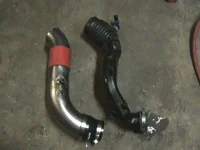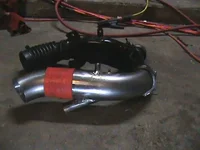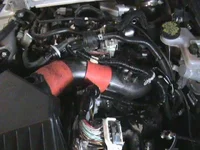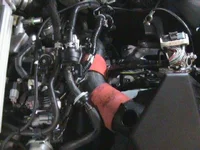Well i got really bored tonight and started playing with my welder LOL. Ive been allittle upset because Cobb has not release there intake yet for the MS3, and im sick of waiting. Ive seen that some company makes a turbo inlet pipe that works with the stock airbox and makes decent power too, so i decided to try and make my own sense im stuck witk the stock airbox for awhile, i figured i might as well make the best of it. I discovered that there is actually room to run a 3'' diameter pipe from the turbo right to the air box with allitlle creativity. I had some let over stainless steel mandrel bends from my custom TBE that i made earlier. i just had to buy a silicone adapter that converts the 3'' to alitte under 2.5 for the actual turbo inlet. I also had to weld in a few fittings, one for the BPV recirculation and one for the FBC and the PVC system. This is what i came up with. So far so good, i havent had time to really test drive it yet but i will tommorow and post results. lemme know what u think so far. thanks
You are using an out of date browser. It may not display this or other websites correctly.
You should upgrade or use an alternative browser.
You should upgrade or use an alternative browser.
Made a turbo inlet pipe!
- Thread starter nig3
- Start date
AutoEuphoria
Member
- :
- '08 CPW Mazdaspeed 3
Looks good, but you might want to heat wrap it. That metal tubing could cause some power loss if it gets heat soaked.
Looks good, but you might want to heat wrap it. That metal tubing could cause some power loss if it gets heat soaked.
would it?
isn't this the same as saying that any intake will cause power loses when it gets heat soaked? have we confirmed in fact that any intake gets heat soaked when the car is moving? wouldn't the inter cooler sort this out?
not flaming just wondering...
AutoEuphoria
Member
- :
- '08 CPW Mazdaspeed 3
Basically, the cooler the air is during its entire journey, the more dense it will be at the end.
Think of it this way...say the ambient under-hood air temperature is something like 90F. Going through the turbocharger might raise it 20F. Going through a hot pipe might raise it 10F (these are just hypotheticals). Going through the intercooler might cool it 20F. You end up with an IAT of 100F. Now take that extra 10F out from the hot pipe, and you have an IAT closer to ambient temperature...denser air, more oxygen, etc. Metal holds heat in longer than plastic.
I haven't seen any true data, but just going by the under-hood layout it seems like temperatures in there might be pretty warm. The large nostrils on the front only direct air through the intercooler, the bottom is covered pretty decently (no air coming in from the bottom), and most of the other air under there has to travel through the radiator first.
All this is speculation, but I'm going from results seen on other cars. GTOs, for example, suffer terribly from heat soak. People added metal intake parts (higher flowing, less restrictive) and saw an even greater rise in IATs...once they wrapped them (or switched to another material), the IATs went down.
On this car, the difference is probably going to be minimal. But hey, to some people every last HP counts.
Think of it this way...say the ambient under-hood air temperature is something like 90F. Going through the turbocharger might raise it 20F. Going through a hot pipe might raise it 10F (these are just hypotheticals). Going through the intercooler might cool it 20F. You end up with an IAT of 100F. Now take that extra 10F out from the hot pipe, and you have an IAT closer to ambient temperature...denser air, more oxygen, etc. Metal holds heat in longer than plastic.
I haven't seen any true data, but just going by the under-hood layout it seems like temperatures in there might be pretty warm. The large nostrils on the front only direct air through the intercooler, the bottom is covered pretty decently (no air coming in from the bottom), and most of the other air under there has to travel through the radiator first.
All this is speculation, but I'm going from results seen on other cars. GTOs, for example, suffer terribly from heat soak. People added metal intake parts (higher flowing, less restrictive) and saw an even greater rise in IATs...once they wrapped them (or switched to another material), the IATs went down.
On this car, the difference is probably going to be minimal. But hey, to some people every last HP counts.
Last edited:
it would be the best to make turbo inlet out of silicone like cobb is using in their intake....
maybe... but one this big, i doubt it, the sucking from the turbo will cause the silicone to collapse in on itself. this was an issue using silicone as the main material on the turbo inlet pipes on my old WRX. Im happy with mine and will take stainless steel over the crappy small brittle plastic stock one anyday. And being heatsoaked!!LOL i think we should worry more about our intercooler being right on top of the motor getting heatsoaked before the turbo inlet pipe does LOL.
SPEED3TYPE2
Member
looks good man!!
AutoEuphoria
Member
- :
- '08 CPW Mazdaspeed 3
the sucking from the turbo will cause the silicone to collapse in on itself
The air coming from the turbo would be pressurized, not under vacuum. I don't see how it would collapse.
SharkDiver
Member
- :
- Speed3
I dont think the few extra degrees is going to make much of a diffrence since the air goes thru the turbo and gets heated up in a big way.I remember Cobb saying something about the diffrence between a cai and sri not mattering much because of the turbo.If it was a na car then it would matter.Basically, the cooler the air is during its entire journey, the more dense it will be at the end.
Think of it this way...say the ambient under-hood air temperature is something like 90F. Going through the turbocharger might raise it 20F. Going through a hot pipe might raise it 10F (these are just hypotheticals). Going through the intercooler might cool it 20F. You end up with an IAT of 100F. Now take that extra 10F out from the hot pipe, and you have an IAT closer to ambient temperature...denser air, more oxygen, etc. Metal holds heat in longer than plastic.
I haven't seen any true data, but just going by the under-hood layout it seems like temperatures in there might be pretty warm. The large nostrils on the front only direct air through the intercooler, the bottom is covered pretty decently (no air coming in from the bottom), and most of the other air under there has to travel through the radiator first.
All this is speculation, but I'm going from results seen on other cars. GTOs, for example, suffer terribly from heat soak. People added metal intake parts (higher flowing, less restrictive) and saw an even greater rise in IATs...once they wrapped them (or switched to another material), the IATs went down.
On this car, the difference is probably going to be minimal. But hey, to some people every last HP counts.
AutoEuphoria
Member
- :
- '08 CPW Mazdaspeed 3
I was mistakenly thinking that this pipe went between the turbo and the intercooler (charge air, not intake air), so I appologize for that. This car is still new to me.
BTW-- I had a chance to drive the car around today and there is huge difference in spool time, boost comes so fast now that its like im not even turbocharged anymore LOL!! and there is definate improvment in power all over the rpm range.
Do you guys think this inlet pipe constitutes a map change on my cobb AP?? right now im running stage 2 v102 which is meant for a stock intake. im wondering if i should try the stage 2 SF map sense ive increased the air flow capability of the OEM airbox so much??
Do you guys think this inlet pipe constitutes a map change on my cobb AP?? right now im running stage 2 v102 which is meant for a stock intake. im wondering if i should try the stage 2 SF map sense ive increased the air flow capability of the OEM airbox so much??
It's the air going TO the turbo, so yes vacuum. BUT they usually use metal wire to reinforce the silicone, hence no collapsing.
Don't forget that the inlet is connected to a moving engine and the other side of the inlet is connected to a somewhat fixed intake. The silicone inlet would need to hold up against the suction and the forces acting on it as the engine pushes it against the intake. Motor mount upgrade, problem solved, but not everyone wants a motor mount upgrade.
A metal inlet with ceramic coating is just as good. Someone posted a 7 degree drop in boost temp from the stock inlet to a ceramic coated metal inlet.
Nice looking inlet Nig. Make sure those welds are spotless inside. Also, you might think about putting a mounting flange on it.
bykeryder4life
Member
so basically it looks like all I need to make one is a 90 degree bend and a 45ish degree bend then some couplers/fittings for bpv/ pcv system or whatnot. i wanna make a 2.75 inch one to match my MS CAI size
no the oem BOV sounds the same maybe i tiny bit louder, the most noticeable new sound its the turbo spooling, its sound pretty cool, more pronounced now. I wasnt trying to make my car any louder though, in fact i like it when cars look and sound stock but actually fly LOL... SLeepers rule!!
maybe... but one this big, i doubt it, the sucking from the turbo will cause the silicone to collapse in on itself. this was an issue using silicone as the main material on the turbo inlet pipes on my old WRX. Im happy with mine and will take stainless steel over the crappy small brittle plastic stock one anyday. And being heatsoaked!!LOL i think we should worry more about our intercooler being right on top of the motor getting heatsoaked before the turbo inlet pipe does LOL.
It will collapse if it's not reinforced. Samco and Forge make some good reinforced silicone tubes.
speed3se-r
Member
looks good. You know, you could make a little $$ on the side if you want to make these for people...i'd be interested. just a thought...
New Posts and Comments
- Replies
- 0
- Views
- 41
- Replies
- 2
- Views
- 141
- Replies
- 0
- Views
- 39
New Threads and Articles
-
-
Ford Lynx RS 2.0 (rebadged Mazda Protege) cranks but won't start
- By immarko
- Replies: 0
-




